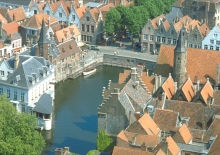Belgium

View of Brugge
Belgium, a country of less than twelve thousand square miles, is
a small country with big cultural appeal; in fact, Belgium is a
nation of multiple cultures and has been for ages, not only in this
modern era of globalisation. Flemish (a form of the Dutch
language), French and even German are spoken in this mini melting
pot of European cultures that converge in this charming coastal
nation. The following article discusses the many facets of Belgium
for would-be travellers who plan to visit a nation of great
interest and beauty.
Belgium is made up of regions and each one is culturally quite
singular. The country borders the North Sea to the east, France to
the south, Luxembourg and Germany to the east and the Netherlands
to the north. These bordering influences have had a great impact on
Belgium historically giving way to the country's nickname as the
"crossroads of Europe." The area that borders the sea is known as
the lowlands region. As early as the eighth century, Belgians built
canals near the coast to drain the seawater using windmills for
which the Dutch are so famously known for. Many visitors come to
the Belgian coast to enjoy swimming at the popular beaches.

Capital: Brussels
Languages: Flemish, Dutch, French, German
Time: GMT +1 hr
Currency: euro (EUR)
The western region of the country is known as Flanders and
Flemish is spoken here with great pride. Flemish speaking peoples
once fought in the streets to keep the rights to speak their
language. The eastern half of the country is known as Wallonia;
most people speak French here. As travellers leave the coast and
move through Flanders they will come to the Central Plateau where
Brussels, the capital of Belgium sits. This area is famous for its
rich farmland. Travellers will want to add the following important
cities to their Belgian itinerary: Charleroi, Liege, and Namur;
these are situated near the picturesque Meuse River. Of course,
before leaving the lowland region, be sure to visit Antwerp that
sits on the Schelde River; this busy port is a leading
diamond-trade centre.

A canal in Bruges
A visit to Belgium should invariably include the historic city
of Bruges, the capital of West Flanders. The old section of this
popular Belgian city includes medieval architecture and canals that
are of great interest to many travellers. Ghent is the capital of
East Flanders and is historically famous for its textile
industries. Belgium lace is considered renowned the world over.
Liege, which is in Wallonia, is famous for its eleventh century
churches.
This hilly, forested and least-populated part of Belgium is
known as the Ardennes. There are many German-speaking peoples in
this area which is famous for its sports and lovely scenery. The
popular tourist town of Spa is known the world over for its mineral
waters and mud baths; even the ancient Romans are known to have
benefited from the healing waters of this area. Travellers to
Belgium may also wish to plan stops in the lovely villages of Arlon
and Durbuy in the Ardennes region.
Finally, many visitors come to Belgium to revisit its infamous
battlefields of the World War I. In 1914, Germany invaded Belgium
despite its neutrality and some of the fiercest battles were fought
on its soil. The city of Ypres was essentially levelled, and much
of Flanders witnessed the horrors of that war. Nearly 80,000
Belgians were killed. Out of remembrance for the British, French
and Americans killed there, many monuments to those who fought
bravely for Belgium can be found in the fields there.
Consequently, many who visit Belgium will find many historic
sites of interest. The cities retain much of this old-world charm
despite much modernisation. When visiting the country, be prepared
for great beer and pastries as well as a people who are intensely
proud of their great nation.

 Belgian Beer Tour
Belgian Beer Tour Belgian Beer Tour
Belgian Beer Tour